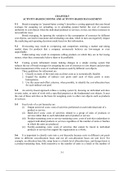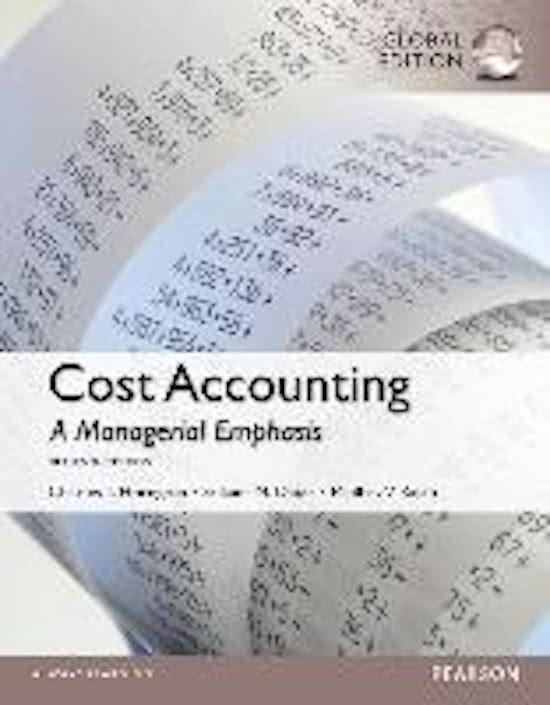CHAPTER 5
ACTIVITY-BASED COSTING AND ACTIVITY-BASED MANAGEMENT
5-1 Broad averaging (or “peanut-butter costing”) describes a costing approach that uses broad
averages for assigning (or spreading, as in spreading peanut butter) the cost of resources
uniformly to cost objects when the individual products or services, in fact, use those resources in
non-uniform ways.
Broad averaging, by ignoring the variation in the consumption of resources by different
cost objects, can lead to inaccurate and misleading cost data, which in turn can negatively impact
the marketing and operating decisions made based on that information.
5-2 Overcosting may result in overpricing and competitors entering a market and taking
market share for products that a company erroneously believes are low-margin or even
unprofitable.
Undercosting may result in companies selling products on which they are in fact losing
money, when they erroneously believe them to be profitable.
5-3 Costing system refinement means making changes to a simple costing system that
reduces the use of broad averages for assigning the cost of resources to cost objects and provides
better measurement of the costs of overhead resources used by different cost objects.
Three guidelines for refinement are
1. Classify as many of the total costs as direct costs as is economically feasible.
2. Expand the number of indirect cost pools until each of these pools is more
homogenous.
3. Use the cause-and-effect criterion, when possible, to identify the cost-allocation base
for each indirect-cost pool.
5-4 An activity-based approach refines a costing system by focusing on individual activities
(events, tasks, or units of work with a specified purpose) as the fundamental cost objects. It uses
the cost of these activities as the basis for assigning costs to other cost objects such as products
or services.
5-5 Four levels of a cost hierarchy are
(i) Output unit-level costs: costs of activities performed on each individual unit of a
product or service.
(ii) Batch-level costs: costs of activities related to a group of units of products or
services rather than to each individual unit of product or service.
(iii) Product-sustaining costs or service-sustaining costs: costs of activities undertaken to
support individual products or services regardless of the number of units or batches
in which the units are produced.
(iv) Facility-sustaining costs: costs of activities that cannot be traced to individual
products or services but support the organization as a whole.
5-6 It is important to classify costs into a cost hierarchy because costs in different cost pools
relate to different cost-allocation bases and not all cost-allocation bases are unit level. For
example, an allocation base like setup hours is a batch-level allocation base, and design hours is
a product-sustaining base, both insensitive to the number of units in a batch or the number of
5-1
,units of product produced. If costs were not classified into a cost hierarchy, the alternative would
be to consider all costs as unit-level costs, leading to misallocation of those costs that are not
unit-level costs.
5-7 An ABC approach focuses on activities as the fundamental cost objects. The costs of
these activities are built up to compute the costs of products, and services, and so on. Simple
costing systems have one or a few indirect cost pools, irrespective of the heterogeneity in the
facility while ABC systems have multiple indirect cost pools. An ABC approach attempts to use
cost drivers as the allocation base for indirect costs, whereas a simple costing system generally
does not. The ABC approach classifies as many indirect costs as direct costs as possible. A
simple costing system has more indirect costs.
5-8 Four decisions for which ABC information is useful are
1. pricing and product mix decisions,
2. cost reduction and process improvement decisions,
3. product design decisions, and
4. decisions for planning and managing activities.
5-9 No. Department indirect-cost rates are similar to activity-cost rates if (1) a single activity
accounts for a sizable fraction of the department’s costs, or (2) significant costs are incurred on
different activities within a department but each activity has the same cost-allocation base, or (3)
significant costs are incurred on different activities with different cost-allocation bases within a
department but different products use resources from the different activity areas in the same
proportions.
5-10 “Tell-tale” signs that indicate when ABC systems are likely to provide the most benefits
are as follows:
1. Significant amounts of indirect costs are allocated using only one or two cost pools.
2. All or most indirect costs are identified as output-unit-level costs (i.e., few indirect
costs are described as batch-level, product-sustaining, or facility-sustaining costs).
3. Products make diverse demands on resources because of differences in volume,
process steps, batch size, or complexity.
4. Products that a company is well suited to make and sell show small profits, whereas
products that a company is less suited to produce and sell show large profits.
5. Operations staff has significant disagreements with the accounting staff about the
costs of manufacturing and marketing products and services.
5-11 The main costs and limitations of ABC are the measurements necessary to implement the
systems. Even basic ABC systems require many calculations to determine costs of products and
services. Activity-cost rates often need to be updated regularly. Very detailed ABC systems are
costly to operate and difficult to understand. Sometimes the allocations necessary to calculate
activity costs often result in activity-cost pools and quantities of cost-allocation bases being
measured with error. When measurement errors are large, activity-cost information can be
misleading.
5-12 No, ABC systems apply equally well to service companies such as banks, railroads,
hospitals, and accounting firms, as well merchandising companies such as retailers and
5-2
,distributors when products make diverse demands on resources because of differences in volume,
process steps, batch size, or complexity.
5-13 No. An activity-based approach should be adopted only if its expected benefits exceed its
expected costs. It is not always a wise investment. If the jobs, products, or services are alike in
the way they consume indirect costs of a company, then a simple costing system will suffice.
5-14 Increasing the number of indirect-cost pools does NOT guarantee increased accuracy of
product or service costs. If the existing cost pool is already homogeneous, increasing the number
of cost pools will not increase accuracy. If the existing cost pool is not homogeneous, accuracy
will increase only if the increased cost pools themselves increase in homogeneity vis-à-vis the
single cost pool.
5-15 The controller faces a difficult challenge. The benefits of a better accounting system
show up in improved decisions by managers. It is important that the controller have the support
of these managers when seeking increased investments in accounting systems. Statements by
these managers showing how their decisions will be improved by a better accounting system are
the controller’s best arguments when seeking increased funding. For example, the new system
will result in more accurate product costs, which will influence pricing and product mix
decisions. The new system can also be used to reduce product costs, which will lower selling
prices. As a result, the customer will benefit from the new system.
516 (20 min.) Cost hierarchy.
1. a. Indirect manufacturing labor costs of $825,000 support direct manufacturing labor
and are output unit-level costs. Direct manufacturing labor generally increases with
output units and so will the indirect costs to support it.
b. Batch-level costs are costs of activities that are related to a group of units of a product
rather than each individual unit of a product. Purchase order-related costs (including
costs of receiving materials and paying suppliers) of $525,000 relate to a group of
units of product and are batch-level costs.
c. Cost of indirect materials of $160,000 generally changes with labor hours or machine
hours which are unit-level costs. Therefore, indirect material costs are output unit-
level costs.
d. Setup costs of $365,000 are batch-level costs because they relate to a group of units
of product produced after the machines are set up.
e. Costs of designing processes, drawing process charts, and making engineering
changes for individual products, $287,500, are product sustaining because they relate
to the costs of activities undertaken to support individual products regardless of the
number of units or batches in which the product is produced.
f. Machine-related overhead costs (depreciation and maintenance) of $950,000 are
output unit-level costs because they change with the number of units produced.
g. Plant management, plant rent, and insurance costs of $512,000 are facility-sustaining
costs because the costs of these activities cannot be traced to individual products or
services but support the organization as a whole.
2. The complex karaoke machine made in many batches will use significantly more batch-
level overhead resources compared to the simple karaoke machine that is made in a few batches.
5-3
, In addition, the complex karaoke machine will use more product-sustaining overhead resources
because it is complex. Because each karaoke machine requires the same amount of machine-
hours, both the simple and the complex karaoke machine will be allocated the same amount of
overhead costs per karaoke machine if Forrester uses only machine-hours to allocate overhead
costs to karaoke machines. As a result, the complex karaoke machine will be undercosted (it
consumes a relatively high level of resources but is reported to have a relatively low cost) and
the simple karaoke machine will be overcosted (it consumes a relatively low level of resources
but is reported to have a relatively high cost).
3. Using the cost hierarchy to calculate activity-based costs can help Forrester to identify
both the costs of individual activities and the cost of activities demanded by individual products.
Forrester can use this information to manage its business in several ways:
a. Pricing and product mix decisions. Knowing the resources needed to manufacture and
sell different types of karaoke machines can help Forrester to price the different
karaoke machines and also identify which karaoke machines are more profitable. It
can then emphasize its more profitable products.
b. Forrester can use information about the costs of different activities to improve
processes and reduce costs of the different activities. Forrester could have a target of
reducing costs of activities (setups, order processing, etc.) by, say, 3% and constantly
seek to eliminate activities and costs (such as engineering changes) that its customers
perceive as not adding value.
c. Forrester management can identify and evaluate new designs to improve performance
by analyzing how product and process designs affect activities and costs.
d. Forrester can use its ABC systems and cost hierarchy information to plan and manage
activities. What activities should be performed in the period and at what cost?
5-17 (25 min.) ABC, cost hierarchy, service.
1. Output unit-level costs
a. Direct-labor costs, $146,000
b. Equipment-related costs (rent, maintenance, energy, and so on), $350,000
These costs are output unit-level costs because they are incurred on each unit of materials
tested, that is, for every hour of testing.
Batch-level costs
c. Setup costs, $430,000
These costs are batch-level costs because they are incurred each time a batch of materials
is set up for either HT or ST, regardless of the number of hours for which the tests are
subsequently run.
Service-sustaining costs
d. Costs of designing tests, $264,000.
These costs are service-sustaining costs because they are incurred to design the HT and
ST tests, regardless of the number of batches tested or the number of hours of test time.
5-4






